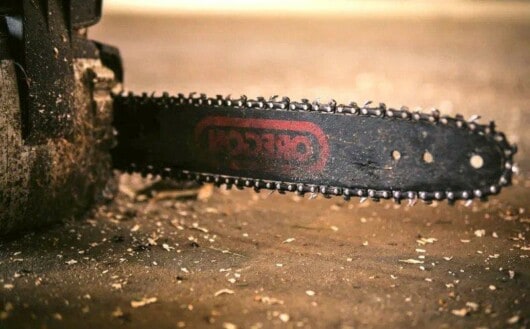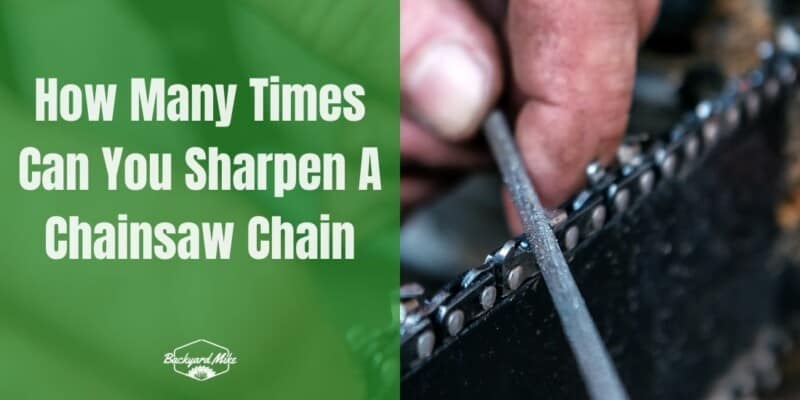Do you feel like your chainsaw isn’t performing as it used to 4-5 sessions ago and bouncing off the wood? This is because a chainsaw loses its sharpness after a few sessions, and it needs to be sharpened again.
This begs the question, how many times can I sharpen a chainsaw chain? The answer is fairly simple, it depends on the type of wood you’re cutting and how frequently you cut wood. To dive deeper into the answer, continue reading the article. You will get to know all about a chainsaw chain’s life expectancy, how many times you can sharpen it, what steps you can take to keep it sharp for longer, and more.
What is the life expectancy of a chainsaw chain?
Under normal circumstances, you’ll be able to get hundreds of hours of proper use from a single chainsaw chain. As surprising as it may sound, this is actually true. The cutters on the chain are essentially individual steel blades, sort of like knives. How often do you need to replace a kitchen knife, especially the ones you don’t use regularly? Every 10 years or so?
However, the lifespan of your chainsaw chain will also depend on the way you use it. The level of maintenance and how often you use the chainsaw will be key factors. Now comes the important question, how many times can you sharpen a chainsaw chain?
How many times can you sharpen a chainsaw chain before replacing it?
How many times can I sharpen my chainsaw chain is a question relative to every individual chainsaw. Different users and their different ways of using the chainsaws bring different results. A rule of thumb is to resharpen the chainsaw chain on the second or third fuel refill. You should ensure that you’re sharpening it once it becomes dull to keep the chain in great condition. Further, you should avoid hitting any rocks or dirt as it’ll dull your chainsaw blades. With that said, you can easily sharpen a chainsaw chain around 12-15 times. After that, your chain will cease to function properly, and you’ll need to buy a replacement chain.
If you frequently use chainsaws, you shouldn’t worry about changing the chain before at least 5 years. However, if your chainsaw use is fairly limited, your chainsaw chain can easily last a decade or so.
Sharpening the chainsaw chain will not only improve the chainsaw’s performance, but also prevent potential kickback issues. When operating a chainsaw, you shouldn’t forget to wear protective gear like eyewear, gloves, steel-toed shoes, and ear protection. Another point to keep in mind is to turn off the cabin and prop it steadily on a solid surface.
After that, you should check the user manual and know the correct sharpening angle and the file diameter. A rule of thumb is to use the round one with a diameter of 4-6 mm. Tighten the chainsaw chain, then start filing from the inside edge to the outside part. Never rotate the file as you’re using it, and be careful with the tooth. You wouldn’t want to push them upward or downward as you’re sharpening them. File them until every tooth is of the same look and same size.
The depth gauge should be filed too, although not as frequently as the cutters. File the gauge teeth flat for keeping the file from potential damage. This should be done in the same direction as the chain cutter. Keeping these tips in mind, your chainsaw chain will remain intact for many years to come.
How to tell if the chainsaw chain is sharp?
Chainsaws deliver their best performance with sharp chains as it maximizes the cutting potential. It is important to know whether the chain is sharp or dull, as it’ll help with chainsaw chain maintenance. It will help you ensure that the chainsaw is properly operating, as all chains gradually lose their sharpness over time. Further, this will make it easier to cut and limit kickback, the biggest source of chainsaw-related accidents.
Here are some signs that will let you know your chainsaw chain is sharp and in prime working condition.
Thick sawdust production
The sawdust produced while cutting trees, wood, or logs indicates whether a chainsaw chain is sharp or not
When you’re vertically cutting wood, the chainsaw needs to produce thick sawdust, almost like coarse strands. A dull chain, on the other hand, will create fine sawdust This will be less thick as compared to what is produced by sharp chains. If the sawdust is smooth and has a finer texture, then it probably means the chain is dull and worn out.
Feels easy to position and cut
If your chainsaw chain is sharp, the chainsaw will be stable without shaking left or right when you’re cutting. If it is worn out, it’ll be harder to position and cut through. It will not be easy to cut the trees, and you’ll notice it is getting stuck despite the engine running. This is one of the simplest ways to find out whether your chainsaw chain is sharp or not.
Efficiency and smoothness
When operating a chainsaw, you aren’t needed to put any external pressure or internal force to cut. If you find yourself needing to put extra pressure on, then it means the chain is dull and worn out. Therefore, it has become a more difficult task to cut through the wood.
Meanwhile, a sharp chain would require little to no pressure, and it’ll be easy to cut through the wood. Situations like this are very helpful as you can easily find out if the chainsaw chain is sharp or not.
How to maintain the sharpness of your chainsaw chain?
There are a few things that you should consider if you want to prolong the life of your chainsaw chain. These steps will help you keep the chainsaw chain working in ideal condition. Aside from the instructions suggested by the user manual, there are a few maintenance tips that you should remember.
After every use, clean the dirt and debris off the chain
Remove the cover of the chainsaw and start cleaning the chain with a piece of metal or wood. Eliminate any last bit of debris or dirt from inside the track. Then, remove and clean the cooling fans and air intake that is found in the cylinder cover. Also, clean out the air filter and wipe any dirt stuck in between tight spaces. Lastly, ensure that nothing is keeping air from getting into the motor by checking the flywheel fins.
Try to store your chainsaw indoors
It is preferable to store your chainsaw inside. Anything from a garage to a shed or even a barn will be fine. Avoid storing your chainsaw outside where it could get damaged by outside climate or other external factors.
Put the chainsaw in a scabbard
Before you put it away after use, you should put the chainsaw in a scabbard. This will prevent any damage from bumps, dust, or dings. Additionally, it’ll also shield you from being on the receiving end of unintentional cuts.

Keep checking the bar and chain oil
Checking the bar and chain oil level must be done each time that it is used. Once you have properly cleaned the debris and assembled the components, the chain and bar need to be oiled properly.
The best way of doing this would be by putting chain oil in the gas tank. Then, run the engine for a few seconds. Most chainsaws these days come with built-in mechanisms to allow the lubricant to automatically draw oil as the chain spins.
At what point can chains not be sharpened and require replacing?
As mentioned above, with time, the chainsaw chain will lose its sharpness and become dull. A dull chainsaw will not only affect the performance, but it’ll affect your safety too. While you can sharpen the chain a few times, but there will come a time you’ll need to replace it. Here are some indicators that your chainsaw chain is too dull and needs to be replaced.
Rusty chain
You should avoid using a rusted chain at all costs. This will damage the teeth and blades, while also decreasing the efficiency of the chainsaw.
Chain is dented or chipped because of improper sharpening
If the chainsaw chain hits rocks or soil, or you’ve improperly sharpened it, and it gets dented or chipped, it should be replaced. In fact, not replacing the chainsaws after this is one of the most common reasons why chainsaws get further damaged. Moreover, if the highest points of the chain are missing, then it is an indication that the chain needs replacing.
If you aren’t getting precise cuts
You will instantly know this when you are trying to cut, and you cannot get the desired cuts. Further, if your chain starts to rattle and clatter, then something might be wrong with the chain.
When you’ve reached the safety lines
Most chainsaw models come with small lines that indicate the maximum limit of metal allowed to be removed. These lines are known as safety lines. Every time you sharpen your chainsaw using a file, you are filing away the metal and approaching the safety lines. Once you’ve reached this line, it isn’t feasible to sharpen, and you won’t be able to use the chain again.
Conclusion
The life expectancy and how many times can you sharpen a chainsaw chain will depend on how you maintain the chainsaw and how frequently you use it. Generally, a chainsaw chain can be sharpened 12-15 times before you cannot sharpen anymore. Then, you’ll need to replace it with a new chain. Regardless of the condition of your chainsaw, it is important to always use a sharp chainsaw chain. Using a dull chain will drastically reduce the performance while also putting your safety at risk.


